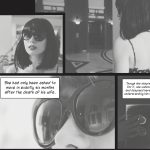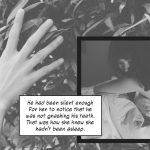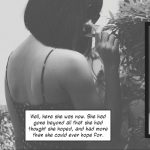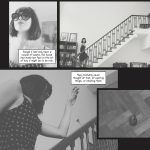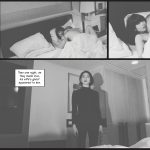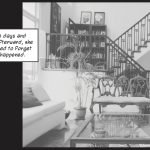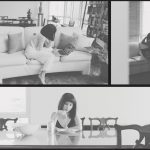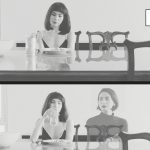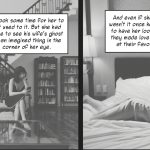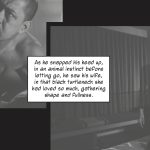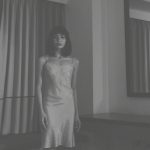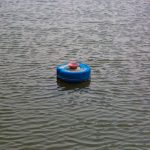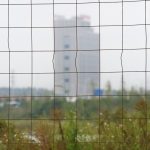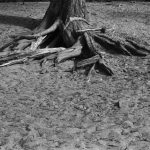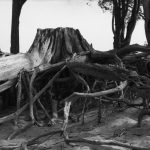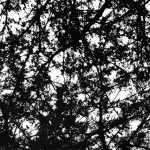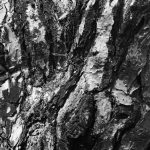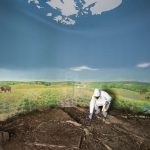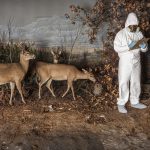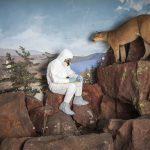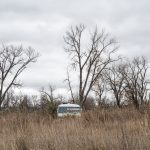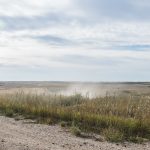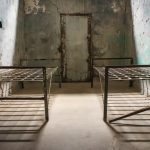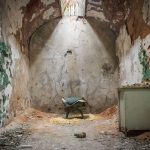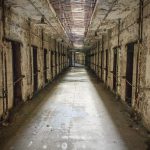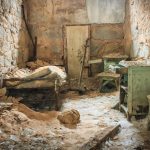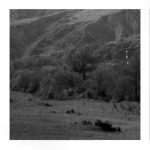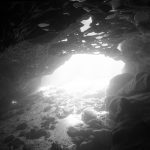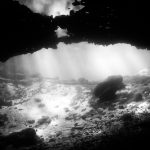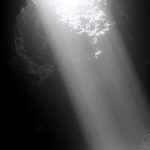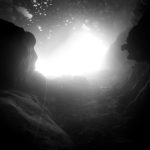Tag: Photography
Elegy for My Father

When he died last month at 91, my dad left boxes and boxes of black-and-white, sepia, and tinted photographs, along with a mahogany crucifix on which the Virgin Mary is suspended. Black hair, probably a horse’s, flows from the Virgin’s scalp and skirts her narrow waist; she has two tiny discs of grey-veined mica for eyes; and her feet are malformed, curving outward like jester shoes. I’d never seen this figurine in my life. I found it in Dad’s pocket a few hours after he died. The oddest thing, however, is that—whether it’s a fault of the woodworker, an act of vandalism, or a consequence of one of my father’s devious moods—the Virgin’s right breast is missing. The left side has an oval hump; but the right side is flat, smooth, and palely smudged as though rubbed vigorously with sandpaper. Along the back of the cross is carved: “To Amelia, from Dad.”
We shared many irreverent jokes; neither of us were orthodox Christians. But this figurine, I admit, makes me uneasy. Why is her breast sanded down? Can a single object inflect the narrative of an entire life?
Dad loved dolls, that I knew. He was the only man I’d ever met who kept an extensive collection of them—enough to fill an entire closet. As a child, I could never step foot in that uncanny sanctuary (or, to my mind, mausoleum) without chastisement; although at times, when he was out photographing the mountain landscapes and mountain people—the thing he loved to do above all others—I’d sneak in and caress their porcelain faces, turn their eyeballs to the left or right, or, when I was especially lonely, embrace them carefully without altering their positions.

There were big dolls and little dolls; conventional ones and quirky ones. I remember waiting for him in his Model T as early as nine years old while he hunted for dolls in drug stores and dusty furniture shops that made my allergies act up. The last doll he bought was in an antique store in Brevard, North Carolina; it was gigantic, dark-haired, with arms as pale and thick as split oak slats (I don’t know why this doll, in particular, finally satisfied his collector’s heart and completed his coven). He photographed them all, but of this Virgin Mary there are no extant photographs.
Dad was what you might call a shutterbug. He conceived of life as an album of images. His memories, for the most part, were tied to particular photographs he’d taken at one time or another. He entered Kodak contests and lost them. He wrote Kodak often complaining about their overrepresentation of northern urban photographers and the relative neglect of southern rural ones in contests; he wrote them about their new products; he wrote them about copyright law. I remember falling asleep to the ring-clack and furious metallic swings and snaps of the typewriter.
In the 1920s and ’30s, during the decline of tenant farming and in the heyday of folk photography, each town or hamlet in rural America had its resident photographer (Dad was born in 1889 and I in 1909). Men and women from Hemlock Cove, Olto, Judaculla, and Gallow Hollow frequented Dad’s studio and the Attic Window darkroom. They’d come with baskets of huckleberries, lovely foot-high April morels, and birch sap candy especially for me. They had names like Mossie Reynard, Earl Palmer, Gideon Laney, Imogene Bascom, Reinfried Romanes, and Max Straub. Like my dad, none of them made a splash in the photography world. At best they placed a few pictures in the Atlanta Journal or Audubon magazine. But Dad never kept friends long. He’d get into some bitter dispute with them about aesthetics or the superiority of a particular strain of vegetable. He had so many of these short-lived artist friends who shared and exchanged photographs with him that it’s impossible for me to know which of the tens of thousands of photographs he left behind are in fact his. The overwhelming majority are, certainly, but the outliers I can’t identify. My eye isn’t sharp enough and perhaps his style wasn’t distinct enough.
Throughout our lives, Dad and I would venture to the obscurest regions of our property, which was five square miles of oak, creek, and granite dome. He called our home in the cove Amelia’s World, because I spent all my time there gardening, walking, and writing while he was off taking pictures. We’d search for lonely abandoned chimneys from the nineteenth century—the relics of the crude cabins of Cherokee and frontiersmen, which often tilted dramatically on uneven ground. These one can find all over western North Carolina, hidden in rhododendron coves: creek rocks rising twelve feet high layered with clay chinking and reinforced with rope, hair, and hog’s blood; the splintered horizontal slats made of poplar. Over time, bees bored into the chinking’s hard pottery. Sometimes we’d light a fire in one of these crumbling hearths and smoke would pour out of the holes.

Dad’s death was a painful one. It feels almost irreverent to speak of it. The few distant cousins who visited struggled to keep their hands from their faces. He had bulging sores resembling purple tomatoes, some split open and oozing as if struck by the blight. His body was like a neglected garden at the onset of winter. I dabbed his sores with a cold cloth day and night during the final struggles. His last wish was for me to cover him with his dolls. His face glowed as he tossed and turned, coughing, spitting up fluid and blood; it jutted out from the top of the porcelain and cotton bodies so that it seemed he wore a grand, puffy Elizabethan dress with ivory lacework.
Dad had many sayings: “the best and worst things in life are errors of the stars”; “we’re just searching for a lucid interval”; “our knowledge is a journey from ruin to ruin.” These cryptic maxims I’ve found myself pondering in the days since his death. Over time, we came to share a similar philosophy. We believed travel outside Appalachia, for instance, would not edify the mind. Close observation of oneself and one’s immediate surroundings is the key to parting the curtains of mystery, however briefly; sense impressions decay into a precarious reality and the laws of nature can change at any moment. But we never held our breath awaiting those changes.
Some of his quirks I picked up. We both preferred corncob pipes with bowls cured with apple butter; it made the brightleaf tobacco from our garden taste sweeter and heavier than molasses (I’m smoking an old corncob right now at my writing desk; my hand shakes more than in the past and I pull the smoke with less vigor, but I experience the same relish as in my early adulthood). Neither Dad nor I owned a mirror. On the rare occasions we looked at our reflections, we did so in the convexities of tablespoons, and only then out of a sense of curiosity, never vanity or self-critique. We should move through life, Dad said, like a living soul in love that knows it’s loved in return, that doesn’t desire more or less as it stands on the bridge between self and other. That was his roundabout way of saying that we should accept our insignificant selves as they are.
I remember the winter it snowed and never let up, the flakes hissing and shifting on the branches, rocks, and roofs. In a fit of rage one day, due to some accident in the darkroom that ruined a batch of prints, Dad threw his ice-crusted walking stick against the wall—and it’s still stuck there. Somehow the tip wedged perfectly between two boards. We thought it quaint to leave it. In later years the walking stick reminded us of that long brutal winter and cut us with nostalgia, remembering the faerie cabins we built with pebbles and bark; the chunks of granite we heated in the stove and used to warm our feet; the icy shock of creek water in our throats; the night we glimpsed a freak offshoot of the northern lights weaving blue and violet nets around the moon; our midnight feasts on crystallized honey; and reading the Gospel of Thomas aloud until we drifted to sleep.

Living with Dad was not always easy. Rarely did we get on each other’s nerves, but there were times, especially towards the end, when he’d come in needy and sulking, desiring compliments. For sixty-plus years we’d discussed the people and places he photographed and the prints he left lying about the kitchen counter or that he had genuine questions about, which my untrained eye could help him clarify. When his body and spirit began to fray, however, he started leaving
photographs in places I’d find when I was alone: on my writing desk, bedspread, and rocking chair; in my tackle box, where I kept my rocks; and in my jewelry box, where I kept some beloved, much-read letters from an old flame. In the garden I once found a Polaroid caught in corn silk. It was a portrait of a woman I’d never met. She had sensuous lips that turned down at the ends and a bold beautiful forehead. Her eyes were closed; a horny crust, some kind of skin condition, populated her eyelids. The next day Dad asked me about it. Was it good or bad? Should he submit it to a magazine?
The first few times he did this I told him how moving the photographs were. I patted him on the back and flicked him affectionately on his balding pate. But as time passed, it angered me that he wanted me constantly to be his praiser and applauder, his confidant in art’s triumphs, failures, and transgressions. I wanted nothing more than the communion of easy laughter and the intimacy of long silence. That was how it had always been. It hurt to alter my attitude toward him, to play a role other than daughter. In the final two years his liberal spiritual convictions began to wear thin, and I suspected he was becoming secretly zealous in a manner he was embarrassed to admit to me, given our long history of unorthodoxy and light heresies. He’d hide himself away in his workshop reading a copy of the New Testament that he’d picked up at the Baptist church down the road. Once, when he lost his pipe, and we couldn’t find it anywhere in the cabin, I heard him mutter: “My God, why hast thou forsaken me?” I laughed. I thought it was a joke, but his expression was solemn. In spite of these things—which I’ve hesitated to commit to paper—he was my only friend and would’ve carried the cross or burned for me. An elegy, unlike a eulogy, should be honest in its longing for souls no longer in reach and should not shirk the hard truths of a complex life.
On the end table, there’s a browning, half-eaten peach with Dad’s bite mark still intact. I can’t throw it away. I think of how often he fretted, especially after he turned eighty, that all the peach trees in North Carolina were dying. He carefully documented their mutilations after the April freeze. He didn’t go exploring the mountains and rivers as far as Asheville anymore, but stayed near Amelia’s World, beekeeping, making muscadine wine, and worrying over our failing orchard. He often related dreams of worms, molds, and hard white blights like baby teeth infesting the fruit.

For some reason I can’t help but connect the missing flesh from this half-eaten peach—where Dad’s long, rabbit-like teeth scored as deep as the stone—with the Virgin Mary’s missing breast; and I can’t help but connect her missing breast to my motherless life. Of all people to have no photographs of, I have none of Mother (never “Mom”). Dad took hundreds of the goat man who visited the byways of Appalachia once a year in his junk-filled wagon pulled by goats; he has thousands—literally thousands—of pictures of purple martins feeding their young from perches in hollowed-out gourds hanging from poles. None, however, of Mother. Dad only started documenting the still, silent world after her death; in his photographs, the mysteries of loss were lulled into chemical innocence.
Mother passed away a few weeks after childbirth when I was two years old (my brother was stillborn). I was too small to remember her. Like clockwork, once a month (during the entire seventy-one years I lived with Dad, up until those final weeks), I’d walk into the house to find him drinking sassafras tea in the kitchen and crying, almost silently, his shoulders heaving. Few things made me so uncomfortable. It transformed me into his parent. I’d always pretend I didn’t see and pass quickly through the room. He never detained me but once. On that particular evening he spoke about Mother, how she had been feverish before she died. She didn’t rave exactly; she was lucid, just bathed in sweat and bright-eyed. She related certain visions: Christ in the desert, hovering, suspended in the air by magnets; a fiery cross erupting on the forehead of a goat; breaking a rock and seeing the face of Jesus inside it. The last vision she related, however, was more intimate.
She told of a day in Oberwolfach in southern Germany, the evening before she and Dad started their long journey to America. They’d decided not to go walking in the windy autumn hills above the village. She couldn’t remember why they’d stayed indoors; maybe they needed more time to pack. But in her vision they had, indeed, gone walking in the hills that day; they’d held hands; they’d kissed each other’s imperfections; they’d talked about what North Carolina might be like as they made for a gap in the trees, where the sun flooded the dim evergreen forest like a bomb’s light.

Dad, you were good to me. You were strong and gentle and careful as a mother. I’m a seventy-one-year-old woman now. When I smile the hundreds of wrinkles on my face hurt like paper cuts. It’s a testament to you that I have no fear of the darkness or the light. As I rotate this effigy of the Virgin Mary back and forth under candlelight, I want to glean more details, to see its mica eyes flash at me. I know that this object is some kind of provocation from you; a sign that I should rethink my life, my past and future, even at this late stage. It makes me wonder what other secrets you kept from me in that red-lit darkroom and in that closet of dolls, which did not replace me, exactly, but acted as a surrogate for something I can’t understand. What perversions, mean hates, and desires so naive and saccharine as to be almost scandalous did you hide from me? And where shall I go now? What shall I do? If I crack open the Virgin’s wooden skull, will there be a ball of mica inside it, a mineral brain not so different from my own? Will a thought rise from it like smoke?
The sky is the dark orange of persimmon beer as I finish this elegy. Orion, the hunter constellation, sparkles along the trees but Sirius has yet to appear above the hill. Perhaps I have twenty more years left, and I’ll die at 91, just like you. But with this inexplicable figurine in my hand, what tables shall I turn to honor, spite, or abandon you? Is the Virgin a key to open the kingdom within?
Future Holdings
Future Holdings documents the abandoned construction site for what would have been the tallest building in the world (Sky City) in Changsha, China. After a few short weeks of building activity in 2015, government authorities halted all construction and local residents eventually allowed the foundation to fill with water and become a fishing pond. Located on the northern edge of Changsha, Sky City would have been the first structure visitors would come across as they traveled along the Xiangjiang River. Today, though, the only elements that tower over this habitat are the construction cranes that fill the horizon. I first photographed this site in 2016 and have returned each year since. Each time, I was struck by the calm and quietness that enveloped this landscape despite the fact that with more than 7 million residents, Changsha would rank as the second largest city in the United States. My goal with Future Holdings is to investigate political, economic, social, and cultural aspects of our contemporary lives through issues of hubris, the relationship between humans and nature, and the evolution of cities like Changsha.
Green Matter / Gray Space
Green Matter / Gray Space is a play on words from the terms “green space” (an area of grass, trees, or other vegetation set apart for recreational or aesthetic purposes in an otherwise urban environment) and “gray matter” (the darker tissue of the brain and spinal cord, consisting mainly of nerve cell bodies and branching dendrites). The increasing population growth in cities calls into question (or enters into a gray area) the future of green space. When every area of a city is constructed for housing and other buildings, the area of green space per capita shrinks. If the vegetation that has, over time, been ripped out to make space for more human activity can be thought of as the gray matter of the ecosystem, what is it that we are doing to the intelligence of our planet’s environment? With climate change, our insatiable waste, and minimization of plant life, how will our health as city dwellers be impacted by the diminishing environment we rely upon for water, air, and food?
Broken Models
Rachel Poliquin, in her 2012 book The Breathless Zoo, writes that “Taxidermy is deeply marked by human longing,” revealing our hopes and dreams about our place in the natural world. Natural history dioramas present a carefully constructed, perfectly encapsulated and controlled experience of nature, revealing as much about humanity as the nature depicted. In Broken Models, Steensma Hoag negotiates access to dioramas in various stages of being decommissioned and uses these fictional spaces to create imaginary scenes. By introducing a worker wearing a white Hazmat suit, which evokes images of advanced technology labs in which the environment needs to be protected from the worker, the series suggests a scientific method of understanding and quantifying our experience of nature and comments on our failed construction of the environment as an inexhaustible resource.
Evolution of a Production Landscape
The Production Landscape series profiles the path of the Dakota Access Pipeline (DAPL) in North Dakota, one of the four states it crosses. For people like me who grew up in suburbia, massive infrastructure projects such as the Dakota Access Pipeline are abstractions. I benefit from the resources they transport, but the costs of such delivery systems are born by others in far away “fly over” places. Beginning in Fall 2016 I followed the pipeline route in North Dakota and photographed the landscapes it traversed. I wanted to see what construction looked like from the ground and view the range and agricultural landscapes reshaped by its insertion. The project does not attempt a comprehensive documentation of the pipeline route or the Bakken-producing region from which the oil is generated, but rather seeks to add context to an important public discussion about natural resource usage. The images highlight the physical disruption of the land’s surface and show the rural areas impacted by its construction. In doing so, the series explores the ways in which landscape photography contextualized current debates related to land-use and natural resource extraction.
Redemption
This series of photographs examines the abandoned prison cells of Eastern State Penitentiary in Philadelphia, Pennsylvania. The Penitentiary subscribed to a theory of rehabilitation that proscribed confinement and a lack of interaction with other inmates. This ran counter to the prevailing system in the United States at the time where harsh physical punishment was the norm. Ideas of church and religious experience are embodied in the building and served as a guide for how prisoners should be rehabilitated: hallways looked like that of a church; low doorways required one to bow and seek penance from a greater power; and a single small skylight, acting as the “eye of God” lit each cell.
Visual Haiku
The photographs in these “visual poems” were taken with a Holga toy camera in the Far East; they represent research undertaken into Chinese and Japanese aesthetic principles and traditions of representation. The elements and principles of art have been used to translate the characteristics of Japanese short poetry – such as economy and the linking of dissimilar things – into the syntax of visual language. As wordless artworks, however. the poems consist entirely of the associations and allusions suggested by the images; the viewer / reader decides the meanings as the poems are open-ended and meditative, having floated free of words.
Under Florida
When we think about light, it is generally in the context of it projecting through the medium of air. Light reaches onto objects and by its reflection on the surface renders them visible. However, when light projects through the medium of water, it behaves differently. Water acts more like a lens that distorts in a number of ways, bubbles, amplification in size, murkiness, etc. When photography attempts to capture light in the liquid medium it relies on conventions established by the medium of light. The liquidity of light would be a state in which the immaterial of light projecting through water gives it materiality. They both become something else, light becomes a property of the liquid and vice versa: the liquidity of light.
